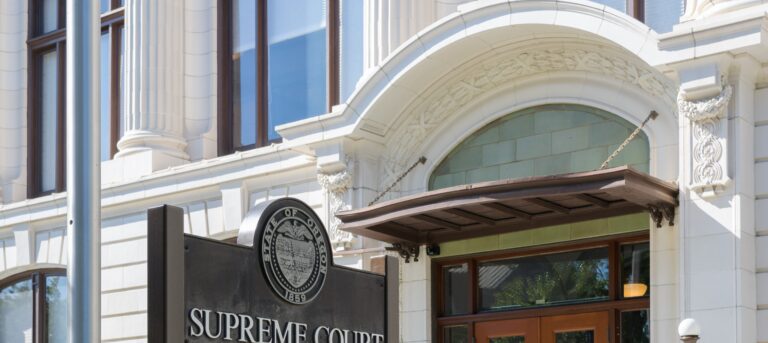Oregon Court of Appeals Holds Once You Leave Safe Harbor You Cannot Re-Enter
From the Desk of Melanie Rose:
Safe harbor is an important aspect of UIM claims as it provides an avenue to escape the general rule that prevailing plaintiffs in insurance policy actions are entitled to attorney fees. In order to gain the “safe harbor” protection from attorney fees, a carrier must agree that the only issues in dispute are liability of the alleged tortfeasor, and the damages incurred by the plaintiff. Any dispute on any topic other than the tortfeasor’s liability and the plaintiff’s damages will remove safe harbor protection. It has become almost second nature for insurers to send safe harbor letters to gain protection from attorney fees. While safe harbor may be attained quickly with just a letter, an insurer should also be mindful that it is possible to “sail out” of the safe harbor at any stage in the case—even mid-trial. As the Court of Appeals held recently once you leave safe harbor you cannot re-enter.
Claims Pointer:
The Oregon Court of Appeals held that the defendant insurer left safe harbor when it refused to stipulate that the at-fault driver was underinsured, despite the fact that the definition of “underinsured” being offered was incorrect. Defense counsel argued that they could not stipulate that the tortfeasor was underinsured because the definition of “underinsured” offered by the court would lead the jury to believe that they must award damages to the plaintiff. The Court was not persuaded by defendant’s explanations for the refusal to stipulate and held that the refusal led to the injection of an issue other than liability and damages—the foundational “coverage” issue of whether the tortfeasor was, in fact, underinsured. The Court found that the refusal to stipulate that the tortfeasor was underinsured resulted in the carrier leaving safe harbor, never to be able to return. Not only was the defendant liable for attorney fees incurred over nine years of litigation, but the Court also held that a lodestar fee calculation on top of the plaintiff’s contingency agreement was reasonable.
Thoens v. Safeco Ins. Co., 317 Or App 727 (2022).
Facts:
In 20071, plaintiff was the driver of a vehicle rear-ended by a vehicle operated by Cody Naylin. There was no dispute that Naylin was at-fault for the accident. Plaintiff claimed that the collision caused her serious injuries, including spinal surgery and other treatments for headaches, neck pain, blurred vision, and balance problems.
Plaintiff settled with Naylin’s automobile insurer for his policy limits of $50,000 and then sought additional payment under her UIM coverage from defendant Safeco. Plaintiff’s policy included $500,000 in uninsured and underinsured motorist coverage. Anticipating a possible UIM claim, Safeco sent plaintiff a safe harbor letter accepting coverage and consenting to submit the case to binding arbitration on the limited issues of damages and liability.
The case proceeded to a jury trial. During Motions in Limine, the defense successfully argued that all evidence of insurance policy limits should be excluded because the sole determination the jury needed to make was the total amount of damages caused to the plaintiff by the accident. The defense argued that, if necessary, the court should apply any offsets for the underlying coverage post-verdict without the need for the jury to have information about the limits that could influence their determination of damages. The Motion in Limine was granted and evidence of insurance policy limits was not submitted to the jury.
At the end of trial, the court proposed jury instructions that incorrectly defined the term “underinsured”. The Court’s definition was “A driver is considered underinsured if the driver’s own insurance policy is insufficient to compensate the injured person for all of his or her damages resulting from the driver’s fault or negligence.”
Critically, defense counsel did not object to this definition of “underinsured”. Instead, defense counsel simply refused to stipulate that Naylin was underinsured—arguing that plaintiff’s damages had not yet been determined and therefore it was unknown whether Naylin’s insurance was “insufficient” to compensate plaintiff.
The jury found for defendant on the UIM claim. Plaintiff appealed and the Court of Appeals reversed and remanded the case for a new trial on the UIM claim. The Court of Appeals found that because the jury was not provided with any evidence of policy limits, they could not make a determination regarding whether Naylin was underinsured. The Court reasoned that if the jury had simply been instructed that Naylin was underinsured, then it would not have been error to exclude evidence of policy limits. However, without being told that Naylin was underinsured, the jury would have had to have knowledge of the policy limits in order to make a finding that Naylin was underinsured. On remand, the UIM claim was submitted to binding arbitration, and the defense stipulated to the arbitrators that Naylin was underinsured. The arbitration panel found for plaintiff and awarded her $400,000 in damages (a net of $350,000 after offsets for Naylin’s $50,000 policy limits).
In addition to damages, the arbitration panel appointed a referee under ORCP 65 to determine whether plaintiff was entitled to attorney fees. Defense counsel argued that it had never left “safe harbor” and that refusing to stipulate to an incorrect statement of the law should not invalidate the safe harbor protections. The referee determined that the safe harbor provision had been violated because the refusal to stipulate that Naylin was underinsured created a disputed issue outside of liability and damages stemming from the accident. As a result, the referee found that plaintiff was entitled to $695,605.25 in loadstar attorney fees in addition to the contingency fee that plaintiff’s counsel was entitled to take from plaintiff’s underlying recovery. The trial court entered a general judgment to that effect. Defendant appealed the attorney fee award arguing that it had never sailed out of the safe harbor—if anything it was “dragged out unwillingly” by plaintiff and the trial court.
Law:
In Oregon, prevailing plaintiffs in insurance policy actions are generally entitled to a reasonable attorney fee award. ORS 742.061(1). However, the statute lists two exceptions that allow the insurer to avoid paying attorney fees: “The insurer has accepted coverage and the only issues are the liability of the uninsured or underinsured motorist and the damages due the insured” and “(t)he insurer has consented to submit the case to binding arbitration”. ORS 742.061(3). These exceptions are commonly referred to as “safe harbor”.
Analysis:
On appeal, defendant argued that it was not subject to an attorney fee award because it never voluntarily interjected a disputed issue other than liability and damages into the case. Defendant’s entire case was premised on the belief that Naylin’s policy limits had sufficiently compensated plaintiff for her injuries and that her damages stemming from the accident did not exceed $50,000. Defendant acknowledged that whether Naylin was underinsured became a disputed issue in the case, however, defendant asserted that it retained the protections of safe harbor because defendant had no choice but to refuse to stipulate to avoid conceding that plaintiff’s damages did, in fact, exceed Naylin’s insurance policy limits. Defendant also raised the issue of whether the referee erred in awarding a lodestar fee over and above the contingency fee that plaintiff’s counsel recovered from the case proceeds.
The Court of Appeals began by acknowledging that the definition of underinsured used by the trial court was incorrect. The definition provided by the trial court would require the jury to compare Naylin’s policy limits to plaintiff’s damages to determine if Naylin was underinsured. The Court of Appeals confirmed that this was not an accurate statement of the law for determining underinsured status. At the time, the law deemed that all drivers with liability limits lower than a plaintiff’s UIM limits to be “underinsured”. Therefore, while the trial court was using an incorrect and potentially misleading definition of “underinsured”, the Court of Appeals also found that Naylin was actually underinsured because his liability limits of $50,000 were less than plaintiff’s UIM limits of $500,000.
With this background, the Court of Appeals turned to a statutory interpretation of ORS 742.061 to address whether defendant had remained within safe harbor. The Court then noted that safe harbor protections are not permanent and can be lost if the defendant injects additional issues beyond liability and damages for the underlying accident. For a defendant to lose the safe harbor protections, the additional issue must be a true issue or “a matter of live controversy, active contest, or actual dispute”. Robinson v. Tri-Met, 277 Or App 60, 72, 370 P3d 864 (2016), rev den, 361 Or 886 (2017). A single sentence in an Answer or discovery response that touches on issues outside of liability and damages will not remove safe harbor protections if they do not develop into truly “disputed issues” within the case. See Berger v. State Farm Mutual Auto. Ins. Co., 290 Or App 485 (2018).
The Court found that defendant successfully invoked safe harbor protections at the outset of the claim by sending the appropriate letter and stayed within the safe harbor through trial up until the jury instruction phase. The Court stated that at that point, when defendant refused to stipulate that Naylin was underinsured, defendant turned that additional issue into a disputed issue that was different and separate from liability of Naylin for the accident and plaintiff’s resulting damages. Turning to defendants’ contention that plaintiff was the one responsible for raising the prohibited issue, the Court found that it was defendant’s direct action of refusing to stipulate that brought the prohibited issue into controversy. In response to defendant’s argument that it was forced to refuse to stipulate because the definition the court was proposing for articulating why he was underinsured was incorrect, the Court of Appeals found that while the argument served as an explanation for defendant’s decision not to stipulate, the result of the refusal was that defendant contested a non-safe-harbor issue. The Court agreed with plaintiff’s contention that defendant could have objected to the incorrect definition and offered a competing definition consistent with the statute or, in the alternative, ask the judge to make a judicial determination as to Naylin’s underinsured status so that the jury would not need to hear any definition of the term as part of the instruction. The Court of Appeals held that the defendant left the safe harbor because as the case proceeded to the jury, the jury needed to determine whether Naylin was an underinsured driver in addition to liability and damages.
Defendant then argued that if it was subject to attorney fees for leaving the safe harbor, it should only be liable for fees incurred from the time the dispute arose at jury selection until the case was remanded and defendant then stipulated that Naylin was underinsured at arbitration. Defendant argued that by proceeding through the entire arbitration with the stipulation that Naylin was underinsured it had “re-entered” the safe harbor. The Court of Appeals rejected the defendant’s position finding that the purpose of Safe Harbor is to facilitate the speedy resolution of insurance claims. The Court reasoned that allowing an insurer to sail “in and out” of the safe harbor could introduce an element of gamesmanship into claim handling and be counterproductive to the policy goal of speedy resolution. Thus, the Court found that an action as a whole is either fully within safe harbor or not, there can be no “half and half” and no “re-entry”. The Court then held that since defendant had left safe harbor at trial they could not re-enter during arbitration.
Lastly, the Court addressed defendant’s argument that the referee erred in awarding plaintiff loadstar attorney fees based on the hours spent on the case even though counsel had already received a percentage fee of plaintiff’s recovery. Plaintiff and her attorneys had a fee agreement that provided that the attorney would receive 40 percent of any recovery as well as any statutory attorney fees that the court awarded. Defendant objected that the additional $695,605.25 lodestar award was unreasonable because plaintiff’s attorneys had already received fees pursuant to their contingency-fee agreement. The Court did not agree with defendant and stated that the purpose of the statute would be defeated if the mere existence of a contingency fee agreement could be grounds to excuse a defendant from statutory attorney fees. In particular, the Court noted that the statute requires an award of attorney fees in any non-safe harbor action where the plaintiff prevails—the statute says that “a reasonable amount to be fixed by the court as attorney fees shall be taxed as part of the costs of the action and any appeal thereon.” Reviewing this mandatory language, the Court of Appeals found that it was appropriate for the referee to make an award of attorney fees in addition to the contingency fee that plaintiff’s counsel recovered from the case proceeds. Moreover, the court found that the defendant had not submitted sufficient evidence that the fee was otherwise unreasonable in light of the venue, counsel’s skill and experience, the nature of the case, or the injuries alleged. Without strong evidence that the attorney fees awarded were otherwise unreasonable, the Court of Appeals upheld the fees awarded by the referee in their entirety.
The Big Picture:
Safe harbor protections are an integral part of UIM defense, and while it may seem that protection can be easily obtained through a simple letter, it should not be taken lightly. Not only must an insurer properly send a safe harbor letter to gain protection, but the insurer remains responsible for staying within safe harbor throughout the entirety of the case. If a court finds that a carrier has introduced a prohibited issue at any point in the proceedings, the carrier will be responsible for attorney fees—even when it was the trial judge that got the law wrong in the first place.
[1] The facts of this case pre-date Oregon’s amendment of ORS 742.504. Under the 2007 version of the law, a vehicle was considered underinsured if the policy limits covering the vehicle were less that the UIM coverage limits of the insured—a policy to policy comparison. See former ORS 742.504(2)(k)(E). In 2016, an amendment to the law went into effect that changed the definition of underinsured vehicle. Under the current version of the statute, a vehicle is considered underinsured if the policy limits covering the vehicle are less than the damages caused by the accident—a policy to damages comparison.

















